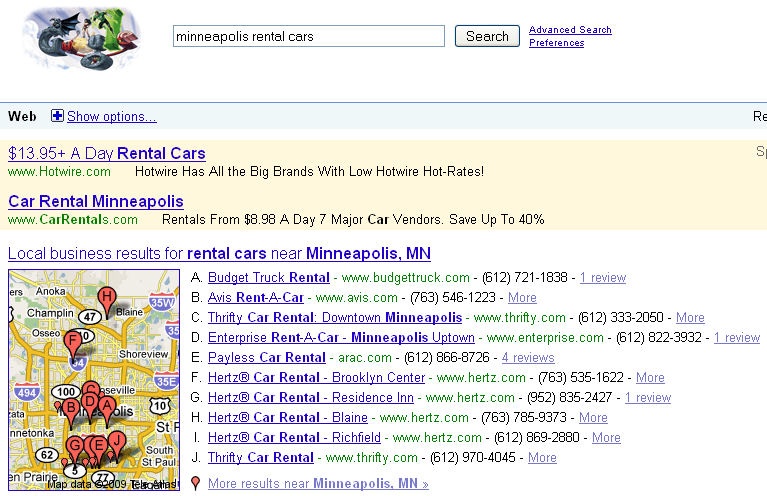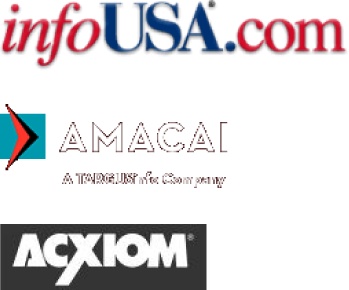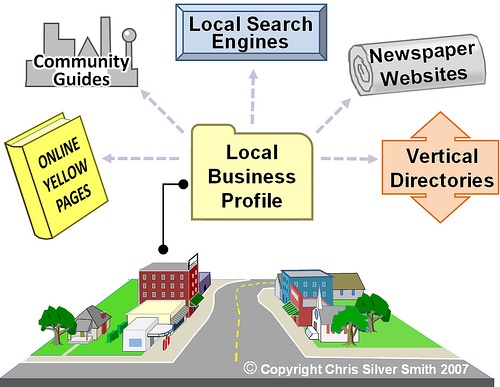Search engines have sought to increase their advertiser base by moving aggressively into providing directory information. Applications such as Google Maps, Yahoo! Local, and Bing Maps have introduced disruptive technology to local directory information by mashing up maps with directory listings, reviews/ratings, satellite images, and 3D modeling—all tied together with keyword search relevancy. This area of search is still in a lot of flux as evolutionary changes continue to come hard and fast. However, these innovations have excited users, and the mapping interfaces are growing in popularity as a result.
Despite rapid innovation in search engine technology, the local information market is still extremely fractured. There is no single dominant provider of local business information on the Internet. According to industry metrics, online users are typically going to multiple sources to locate, research, and select local businesses. Traditional search engines, local search engines, online Yellow Pages, newspaper websites, online classifieds, industry-specific “vertical” directories, and review sites are all sources of information for people trying to find businesses in their area.
This fractured nature of online local marketing creates considerable challenges for organizations, whether they’re a small mom and pop business with only a single location or a large chain store with outlets across the country.
Yet, success in these efforts is critical. The opportunity for local search is huge. More than any other form of vertical search, local search results have come to dominate their place in web search. For example, Figure 8-3 shows the results for a search on minneapolis rental cars.
The regular web search results are not even above the fold. This means that if you are not in the local search database, you are probably not getting any traffic from searches similar to this one.
Obviously, the trick is to rank for relevant terms, as most of you probably don’t offer rental cars in Minneapolis. But if your business has a local component to it, you need to play the local search game.
Today, literally thousands of online directories and websites offer up guides to local businesses. So, if you have a local business or a chain of shops, where do you start?
Directories can be built from the local phone company’s database information, but no one phone company covers the entire country. Because of this, companies that host nationwide directories are primarily getting their content from data aggregators to form the foundation of their guides. Data aggregators build their content from a variety of sources, such as local area Yellow Pages, to have information that is as comprehensive as possible.
Three top aggregators exist for U.S. business listings: InfoUSA, Acxiom, and Amacai, as shown in Figure 8-4.
The first step in managing the online presence of local companies is to check and update the business’s listing information in each of these main aggregators. Ensure that the address information, phone numbers, fax numbers, and any other contact information are correct.
It is also a good idea to check/update your listing information in the top Yellow Pages directory sites, vertical directories (directories that are apropos for your industry), and top local search engines. But how do you decide what the top local information sites are?
As of this book’s printing, the best guide for Internet Yellow Pages, vertical directories, and local search engines is the Local Search Guide provided by the Yellow Pages Association. Check your listings in each of the sites listed in the guide, and update where necessary.
Of the search engines listed in the guide, you’ll focus primarily on their local search or map search sections, and you’ll want to look for how to add/update/edit your listings in them. For instance, you can find the interface for updating listings in the Google, Yahoo!, and Bing search engines at the following URLs:
Google Local Business Center: http://www.google.com/local/add
Yahoo! Local: http://listings.local.yahoo.com/
Bing Local Listing Center: https://ssl.bing.com/listings/ListingCenter.aspx
Google and Microsoft offer methods for validation using automated phone and fax systems. Yahoo! offers a paid service in which the business pays for data maintenance and then gets direct control over its listings.
The major advantage that these systems offer is that you are validating your data directly with the search engines themselves. You can bet that they will treat this as highly trusted data. If the address you validate directly with them is 39 Temple Street and the InfoUSA address is 41 Temple Street, they are probably going to use the 39 Temple Street address.
Search engines are not the only source for local business information. Some of the more notable alternatives include the following.
In addition to the online directories listed in the Local Search Guide, check to see that you’ve also updated your information in any local directory sites that are independent of the Local Search Guide lists. Other Yellow Pages guides may be dominant for your area but may not be listed. Check the printed phone books delivered in the area where your business is located, and see whether they have URLs printed on their covers where you can audit/update your information.
The Local Search Guide lists only a handful of vertical directories, so if your industry isn’t represented in that set, you might do some research to identify ones appropriate for you, and check them to ensure that your business listing is optimal in them.
Check the sites of the top newspapers in your area and see whether they have business directories with a good presence for you.
Most U.S. cities have a local chamber of commerce to help promote businesses in the area, and getting listed within it can be beneficial to you, particularly if the chamber’s site is optimized for search engines; getting your chamber of commerce listing linked over to your website can help with your link weight.
These sorts of sites can be time-consuming to integrate with, but users sometimes conduct local-based searches through them for some types of products and services. Craigslist is the most-used online classifieds site, although there could be more specialized ones for particular cities or industries. Figure 8-5 shows results from an eBay search for stuffed animals.
EBay’s advanced search features allow users to search for things offered by sellers in particular regions/localities. So, for some types of businesses, it could be helpful or worthwhile to list products on eBay. Listing items through online classified or auction sites might not be good for improving direct sales, but it could be worthwhile as another channel for advertising to local consumers.
Loads of local guides are devoted to information about local areas, so search on your city’s name or zip code and see what sites appear on the first page of results in each of the main search engines: Google, Yahoo!, and Bing. Review the top local guide sites for your area and assess whether they’re apropos for your business’s information.
Many niche Yellow Pages directories are geared toward particular demographic groups—for instance, special interest groups or directories in other languages. Consider integrating with the ones that are right for you and your business. Association with these specialized guides may position you for more ready acceptance by the end users of those guides, because it sends them a clear message that you value their interests and are more directly sympathetic to their needs and desires. Here are some examples:
Many online directories and local search engines are adding more dimensions of information onto a business’s basic listing. Providing as much detailed information about your company as possible through these profiles could be beneficial in terms of converting users of those sites into new customers for you. As you pass through each local search engine and directory to check and update your listings, notice what other opportunities may be available to you to enhance your business’s information (see Figure 8-6).
Such enhanced profile information can include things like hours/days of operation, products and manufacturers carried, special offers, years in business, photos, video, slogans, business categories, keywords, certifications, menus, amenities, and payment methods, among others.
Add the URL pointing to your company’s website to any/all of these
local information websites. Nearly all local information websites
NoFollow their links, so they do not
have a direct SEO benefit, but you do want to make it easy for visitors
to these websites to get to your site.
You’ll notice that some directories and search engines are compiling all of this profile information from a variety of sources, so be aware that information supplied to one local information site could automatically begin appearing in many other places.
We will discuss the subject of optimizing your local business profiles in much more detail shortly.
Some companies may be overwhelmed by the prospect of updating and monitoring information through the many avenues we listed earlier. For a small business with just a few locations, the main work is in the initial integration and updates—thereafter you just need to periodically check and intervene as necessary. (You don’t have to do your updating all at once. You could make a list of the most important online sites where your information may appear and methodically work through them as time allows.)
But checking and updating information for dozens to thousands of locations would not really be feasible to do by hand. In those cases, it would probably be sufficient to just focus on the top Yellow Pages, the business information aggregators, and the top search engines—from those information sources, your proper information would likely trickle down to all the rest. If your company has a substantial number of brick-and-mortar stores, you could contact each of the top Yellow Pages, aggregators, and search engines, and offer to supply them with a periodic feed of your business listings.
If you’re still overwhelmed at the prospect of handling the update duties we previously outlined, a number of companies have sprung up to provide a management service for local profile information; if your business has many locations, you should review the cost/benefit of outsourcing the management of your data to one of these specialists. Here are the top three:
GetListed, which has some additional DIY options
If you have been around for a while, your business probably is already included in the local search engines, since they compile data from the aggregators and other online directories. Once your business’s listing is loaded into the local engines, you must determine how to get your business to rank higher when users search for your industry’s keywords. On the next few pages, we will outline things you can do on your website to prepare it for better rankings in local search engines.
All of the basic SEO factors can come into play and can help to
influence your rankings. These factors include having good, specific
text in each page’s title, H1 tags, meta description, page content,
IMG ALT attributes, inbound links,
and so forth. But some things are specific to local search, such as the
following:
If your company has multiple locations, it is not necessary to have a standalone website or subdomain (e.g., loc1.example.com, loc2.example.com, loc3.example.com, etc.) for each outlet. In fact, it is probably better if you don’t, since each business location would likely produce similar website content. However, it probably would be helpful for you to create a separate profile web page on your site for each distinct location. Many sites with chain outlets will list all outlets on one page—that is not optimal. It is better to have one page be about one store location and another about a different location so that you can leverage all the on-page elements to create a page focused on that location.
Have your page title, H1 tags, and content include the business name, type of the business, and location name—for example, “Acme Café: French Restaurant in Boston, MA.” For multiple locations, make the title different on each location’s page. Include the neighborhood, street address, area nicknames, and other location-distinguishing information.
The home page and/or Contact Us page should have the main location’s basic listing information (street address, city, state, zip code, phone numbers, etc.) displayed somewhere in the HTML text. You should also add the basic listing information in the hCard microformat, which is a method for encoding address information on web pages for this purpose (learn more about it at http://microformats.org/). If you have multiple locations, display the basic information on each location’s profile page.
Place differentiating information on each store’s pages, including a map, hours of operation, brand names, product photos, “in business since x" information, menus with prices (if it is a restaurant), ratings (if applicable), certifications, bonded status, and similar information. Of course, include specifics about the physical location, as we previously mentioned.
Be aware of your proximity to your city’s centroid (the location that the search engine defines as the center of the city). This is likely something that you cannot change at this point, but if you were considering moving your company to a new location, take into account where your city’s centroid is located, and try to find a place closer to that point. Many of the map search engines will display the businesses located closest to the centroid first for any particular category or keyword search. Note that this is something that all the search engines now downplay as a factor, as it is less important than it used to be.
Proximity works the same way for zip codes. If a user searches for businesses within a specific zip code, the businesses closest to the zip code area centroid will likely be displayed first in the list. Note, though, that zip code searches are not commonly performed in the United States (you can verify this with your favorite keyword research tool).
It is very nearly a secret that good user ratings are one of the biggest factors for ranking high in a number of the local search engines, particularly Google Maps. Google Maps has compiled ratings from many other directory sources to get a universal rating for a business, so having high average ratings in Judy’s Book, CitySearch, Superpages, Yellowpages.com, and others will help improve your chances to rank higher in map search results.
Google has its own user ratings to combine into the mix as well. But how do you improve these ratings? As always, Google does not want you to artificially influence the reviews, and most of the online ratings have varying degrees of fraud detection, so Google would likely discount reviews if it believes they are being manipulated.
Do not attempt to set up multiple user accounts to rate yourself well or reduce your competition’s ratings, though! Likewise, do not pay customers for beneficial reviews—if such a practice were discovered, you could lose all of your beneficial ratings. Focus on working in ways that are allowed under all the search engines’ rules: just ask people to rate you. By asking enough happy clients to rate you, you might be able to drive up the positive reviews, which can bring rankings benefits. One thing you can do is post a sign on your premises encouraging customers to review your business on Yelp and other places, as well as post a Yelp widget on your site.
As part of good reputation management, you should monitor your online ratings in the various sites, and try to respond to complaints/issues as quickly as possible.
Develop external links pointing to your website. The best links to support local search come from other locally and topically oriented sites with locally and topically oriented anchor text. For example, “Atlanta rental cars” is better anchor text than “rental cars.” Of course, all natural inbound links are beneficial.
If your local business has its own blog, add a blog map or feedmap (http://www.feedmap.net/) to it. This will add a local signal to the blog, as well as bring it to the attention of other bloggers in your area who are also participating in feedmaps.
For businesses such as restaurants, it may be beneficial to add photos of celebrities who have visited the establishment.
This could translate well online, too—people perform searches on celebrity names all the time, so if you are lucky enough to have celebrities frequent your restaurant, uploading photos of them can help attract celebrity watchers to your business. The main thing is that it could drive up inbound links, and get users to linger longer on the site, perhaps bolstering the site’s quality scores.
Community interaction can assist in online promotion. One great way to obtain local area links is to support charitable efforts in the area and to sponsor local events. Although it may seem crass to get link value out of charitable efforts, this is one of the best ways to support your local community while bolstering your business in the online marketplace. Don’t feel guilty for creating a win-win situation! Such opportunities could include:
Local charity races/walks, particularly if they list sponsors or sponsor logos on a page on their site. Request to have those linked to your local business site. Inbound links from these sites are very beneficial, and this is a valid way to get them!
Sponsorship of the local college or high school sports teams and bands. Also, request that they list sponsorships on the school website.
Local fraternal organizations, which may offer opportunities for links. Examples include the Freemasons, Lions Club, and Shriners.
Charitable events that you host yourself. Is anyone organizing the provision of food for the needy at Thanksgiving? If not, organize it yourself and host the information pages off your own website. This could draw many others to link to you as they help in promotion efforts.




